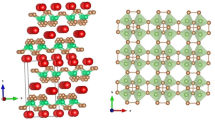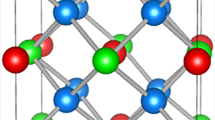Abstract
This paper reports an updated parameterization for a CdTe bond order potential. The original potential is a rigorously parameterized analytical bond order potential for ternary the Cd–Zn–Te systems. This potential effectively captures property trends of multiple Cd, Zn, Te, CdZn, CdTe, ZnTe, and Cd1-xZnxTe phases including clusters, lattices, defects, and surfaces. It also enables crystalline growth simulations of stoichiometric compounds/alloys from non-stoichiometric vapors. However, the potential over predicts the zinc-blende CdTe lattice constant compared to experimental data. Here, we report a refined analytical Cd–Zn–Te bond order potential parameterization that predicts a better CdTe lattice constant. Characteristics of the second potential are given based on comparisons with both literature potentials and the quantum mechanical calculations.





Similar content being viewed by others
References
Schlesinger TE, Toney JE, Yoon H, Lee EY, Brunett BA, Franks L, James RB (2001) Mater Sci Eng 32:103
Kazmerski LL (2006) J Electron Spectrosc Relat Phenom 150:105
Chou HC, Rohatgi A (1994) J Electron Mater 23:31
Potter MDG, Cousins M, Durose K, Halliday DP (2000) J Mater Sci Mater Electron 11:525
Szeles C (2004) Phys Status Solidi A 241:783
Bolotnikov AE, Camarda GS, Carini GA, Cui Y, Li L, James RB (2007) Nucl Instrum Methods Phys Res A 579:125
Ward DK, Zhou XW, Wong BM, Doty FP, Zimmerman JA (2012) Phys Rev B 85:115206
Ward DK, Zhou XW, Wong BM, Doty FP, Zimmerman JA (2012) Phys Rev B 86:245203
Zhou XW, Ward DK, Wong BM, Doty Phys FP (2012) Rev Lett 108:245503
Chaves JJ, Ward DK, Wong BM, Doty FP, Cruz-Campa JL, Nielson GN, Gupta VP, Zubia D, McClure J, Zhou XW (2012) Phys Rev B 85:245316
Zhou XW, Ward DK, Wong BM, Doty FP, Zimmerman JA, Nielson GN, Cruz-Campa JL, Gupta VP, Granata JE, Chavez JJ, Zubia D (2012) Phys Rev B 85:245302
Zhou XW, Ward DK, Wong BM, Doty FP, Zimmerman JA (2012) J Phys Chem C 116:17563
Plimpton S (1995) J Comput Phys 117:1
Pettifor DG, Oleinik II (1999) Phys Rev B 59:8487
Murdick DA, Zhou XW, Wadley HNG, Nguyen-Manh D, Drautz R, Pettifor DG (1999) Phys Rev B 59:8487
Drautz R, Nguyen-Manh D, Murdick DA, Zhou XW, Wadley HNG, Pettifor DG (2004) TMS Lett 1:31
Oh J, Grein CH (1998) J Cryst Growth 193:241
Borges DS, Rino JP (2005) Phys Rev B 72:014107
Kanoun MB, Merad AE, Aourag H, Cibert J, Merad G (2003) Solid State Sci 5:1211
Wang J, Rockett A (1991) Phys Rev B 43:12571
Ward DK, Zhour XW, Wong BM, Doty FP, Zimmerman JA (2011) J Chem Phys 134:244703
Barin I (1993) Thermochemical data of pures substances. Weinheim, VCH
Goodwin L, Skinner AJ, Pettifor DG (1989) Europhys Lett 9:701
Albe K, Nordlund K, Nord J, Kuronen A (2002) Phys Rev B 66:035205
Wolfram S (2004) The mathematica book, 5th edn. Wolfram Research, Champaign
Hestenes MR, Stiefel E (1952) J Res Natl Bur Stand 49:409
Olsson DM, Nelson LS (1975) Technometrics 17:45
Storn R, Price K (1997) J Glob Opt 11:341
Kirkpatrick S, Gelatt CD, Vecchi MP (1983) Science 220:671
Perdew JP, Burke K, Ernzerhof M (1996) Phys Rev Lett 77:3865
Grimme S (2006) J Comput Chem 27:1787
Wong BM, Ye SH (2011) Phys Rev B 84:075115
Donnay JDH, Ondik HM (1973) Crystal data, determinative tables, vol 2, 3rd edn. US Department of Commerce, National Bureau of Standards, and Joint Committee on Power Diffraction Standards, Washington DC
Agrawal BK, Agrawal S (1992) Phys Rev B 45:8321
Rowe JM, Nicklow RM, Price DL, Zanio K (1974) Phys Rev B 10:671
Grigoriev IS, Meilikhov EZ (1997) Handbook of physical quantities. CRC, New York
Acknowledgments
This work is supported by the National Nuclear Security Administration (NNSA)/Department of Energy (DOE) Office of Nonproliferation Research and Development, Proliferation Detection Program, Advanced Materials Portfolio. Sandia National Laboratories is a multi-program laboratory managed and operated by Sandia Corporation, a wholly owned subsidiary of Lockheed Martin Corporation, for the US DOE’s National Nuclear Security
Author information
Authors and Affiliations
Corresponding author
Appendix
Appendix
For the BOP formulation the total energy of a system is expressed as
where ϕ ij(r ij) is a short-range two-body potential, β σ,ij(r ij) and β π,ij(r ij) are, respectively, σ and π bond integrals, Θ σ,ij and Θ π,ij are σ and π bond-orders. ϕ ij(r ij), β σ,ij(r ij), and β π,ij(r ij) are expressed in a general form as
where f ij(r ij) is a Goodwin-Skinner-Pettifor (GSP) radial function [23], and f c,ij(r ij) is a cutoff function (see [7] for formulation). Furthermore, Θ σ,ij is given by:
Where, Φ i2σ and Φ j2σ are local variables arising from electron hop paths. In addition, Φ i2σ and Φ j2σ have the same formulation but are merely evaluated for atoms i and j, respectively. Since only the product of β 2σ,ij (r ij) ⋅ Φ i2σ is required for Eq. (8), the formulations are given as:
where θ jik is the bond angle at atom i spanning atoms j and k, and the function g σ,jik(θ jik) introduces angular-dependent contributions to the bonding resulting from the overlap of the hybridized atomic orbital. The three-body angular function is written as
where g σ,jik, b σ,jik, and u σ,jik are three-body-dependent parameters. The half full valance bond order is given by:
Equation (8) also requires knowing β 2σ,ij (r ij) ⋅ R 3σ,ij given by
The symmetric band-filling function is expressed as the continuous function
where
The π bond-order Θπ,ij used in Eq. (4) is expressed as
where a π,ij and c π,ij are pair parameters, ζ3 and ζ4 are constants, and Φ i2π , Φ j2π , Φ 4π are local variables.
The β 2π,ij (r ij) ⋅ Φ i2π,ij and β 4π,ij (r ij) ⋅ Φ 4π,ij terms used in Eq. (15) can be written as
With
The β 4π,ij (r ij) ⋅ Φ 4π,ij term contains four-body dihedral angles Δψ kk ′ important in π bonding, and can be calculated as
For more detailed discussion and descriptions of all equations, please see [7].
The BOP parameterization of CdTe can be done independently for elemental Cd, elemental Te, and finally for CdTe. As stated above, the ability to capture crystalline growth is a critical component of a high-fidelity interatomic potential. In general, a more transferrable (flexible for many phases) potential is more difficult to parameterize for capturing crystalline growth because the properties of various phases vary more dramatically with changes of the parameters.
Since the refined parameterization only updates the portions of the potential containing CdTe interactions many of the parameters remain consistent with the previous potentials [7, 8]. This particular fitting process includes a total of 40 parameters. However, many parameters can be fixed prior to the fitting process. ζ 1-ζ 4,r 0, r c, r 1, r cut, c σ, a π, f σ, k σ, g 0 are all chosen before optimizing the remaining parameters (see [7] for details). This leaves 25 parameters to be determined.
Rights and permissions
About this article
Cite this article
Ward, D.K., Zhou, X., Wong, B.M. et al. A refined parameterization of the analytical Cd–Zn–Te bond-order potential. J Mol Model 19, 5469–5477 (2013). https://doi.org/10.1007/s00894-013-2004-8
Received:
Accepted:
Published:
Issue Date:
DOI: https://doi.org/10.1007/s00894-013-2004-8




